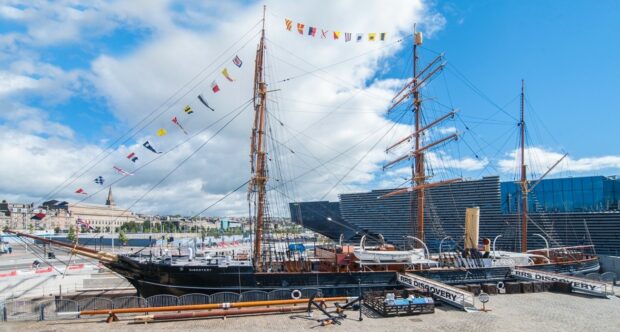
The city of Dundee is celebrating the historic homecoming of RRS Discovery 30 years on from the ship’s emotional last ever voyage.
The polar research ship was built in the city and carried Robert Falcon Scott and Ernest Shackleton on their early 1900s Antarctic expedition.
The world’s first scientific research ship returned home in 1986 and, after extensive restoration work, was moved to new permanent home at Discovery Point in 1992.
As part of the significant milestone, locals are being asked to share their memories of that day and their experience of what the ship means to them.
Harry Simpson, 70, is the former co-owner of MacKay Boat Builders in Arbroath and worked extensively on the ship’s refurbishment and maintenance.
He and son Paul Simpson, who now runs MacKay’s with his wife Lynn Cameron, were both involved in the operation to move the ship to her final home in September 1992.
Simpson recalled: “When I first started working on Discovery, I was completely amazed at the construction and strength of the ship.
“Wooden and steel ships can both be crushed by ice, but Discovery sat there in the ice for months and still came back to Dundee.
“On the day of her return, people were lining the main roads, the docks and the walls along the riverside as we brought her up the river, under the Tay Road Bridge and into the dock.
“It was an honour to be involved and we practised the operation for four months beforehand, towing a caisson [floating lock gate] with a pair of tugs, taking it out to sea, bringing it back in and locking it into place.”
Practice made perfect as, on September 26 1992, the operation to permanently berth Discovery went without a hitch.
The ship underwent extensive work including replacing beams, teak decking, planking, frames, stanchions, top rails and bulwarks.
Alongside the Discovery itself a new £6m purpose-built visitor centre was created and the attraction has since welcomed more than two million visitors.
Those to have stepped on board include The Queen in July 1987, the then Duke and Duchess of Cambridge in October 2015, astronauts who flew on space shuttle Discovery’s last flight in July 2011 and descendants of the original crew, including Captain Scott’s grandson Falcon Scott.
Jim Pettigrew, Chair of Dundee Heritage Trust said: “The arrival of RRS Discovery in 1992 is a hugely important moment in the life of this uniquely important historic ship, finally finding her permanent home after more than 90 years’ absence.
“In many ways the fortunes of Discovery mirror those of the city itself. When she was launched, Discovery was the product of a proud city with a successful boatbuilding heritage, but both had seen their fortunes decline by the middle of the 20th Century.
“Thanks to the commitment and hard work of everyone who has supported Discovery over the years, she is now permanently back home and the jewel in the crown of a revitalised, forward-looking city.”
The last traditional three mast ship to be built in the UK, Discovery started life just a stone’s throw away from Discovery Point.
As a major whaling centre, Dundee’s shipyards had long experience of building ships robust enough to travel through the Arctic pack ice.
Following her launch in 1901, Discovery’s first mission was the pioneering and highly successful British National Antarctic Expedition, carrying a crew of 48 including Scott, Shackleton and Edward Wilson.
The ground-breaking science carried out on this, and later expeditions, produced critical benchmark data and technological innovations that are still used by climate and environmental scientists.
Dundee University’s Dr Simon Cook, an expert in Geographical and Environmental Science, said: “As the world’s first scientific research ship, RRS Discovery occupies a unique position in the history of Scotland’s contribution to scientific knowledge.
“Observations made in the RRS Discovery’s ship logs about sea ice extent, for example, are still being used today to understand longer term changes in ice cover and the climate of this region.”
RRS Discovery’s adventures continued, first with the Hudson Bay Company, then running munitions to Russia during the First World War. She was to make two further voyages to Antarctica before being laid up in London, where she is fondly remembered for her long connection with the Sea Scouts, as the organisation’s training ship between 1936 and 1954.
By 1979, Discovery was in a serious state of dilapidation. The first stage of her restoration was funded by a grant of £500,000 from The Maritime Trust and she departed London’s St Katharine’s Dock on March 27 1986, arriving at Victoria Dock on April 3 and greeted by thousands of people lining the River Tay.
Today, RRS Discovery is an iconic attraction, a symbol of Dundee’s past, but also a hugely important catalyst for the city’s regeneration, sitting alongside the new V&A Dundee museum as the centrepiece of the £1bn Waterfront Development.
Discovery will soon be undergoing further, specialist renovation and repair work to keep her in the best possible condition. As is common with a wooden ship of her age, the fabric of RRS Discovery has deteriorated with an estimated £1.3m of work needed to prevent further damage.
A £409,000 grant from the National Heritage Memorial Fund will pay for the most urgent repair work, with fundraising continuing for the remainder.
Anyone wishing to share memories of RRS Discovery, including her final voyage to Discovery Point can contact the team on social media or by e-mail to Justine.abola@dundeeheritage.co.uk

Enjoy the convenience of having The Sunday Post delivered as a digital ePaper straight to your smartphone, tablet or computer.
Subscribe for only £5.49 a month and enjoy all the benefits of the printed paper as a digital replica.
Subscribe